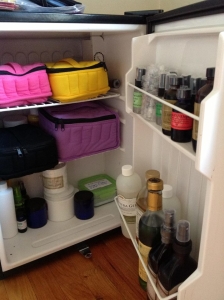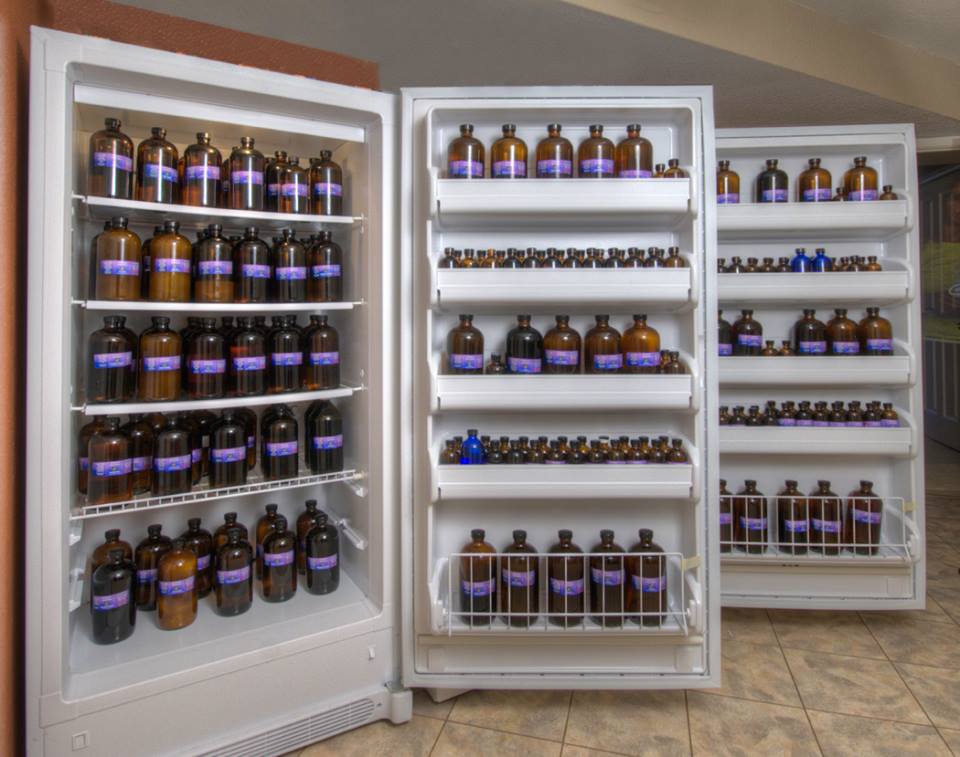Essential oils are happiest when cold & because we live in a tropical part of the world
If you keep them refrigerated they will last twice as long, especially because we live in a tropical climate .
Essential oils are expensive, so you want them to stay active as long as possible!
The ideal temperature for an essential oil is between
35-38 degrees, the temperature of most refrigerators, is great for essential oils. If you fancy keeping them in your freezer that’s OK too, but the additional cooling won’t bring much added benefit. A couple of things to watch out for:
* If you put essential oil bottles into a fridge with food, some of that food may start to taste of essential oil. So keep them in a container: wooden box, plastic box or zip-up bag (see pic below). If you have a large collection of oils, or plan to, buy a dedicated fridge – they come in all sizes.
* Essential oils become progressively more viscous as they cool. This won’t noticeably affect most oils, but some may be slow to pour, and rose otto will go solid. (If it’s undiluted rose otto and it doesn’t go solid in your fridge, then it’s not a genuine otto.) If you do need to slightly warm up an essential oil, hold the bottle in your hand for a minute. But most will be fine.
Cold good, oxidation bad
With time, most essential oil constituents oxidize, and heat promotes oxidation. Once oxidation starts it’s difficult to stop, though it is a very slow process – it takes months. So if you accidentally leave your oils in a hot car for a few hours, don’t worry – they will still be fine. And, changing temperature either way does not bother them, so long as they are cool most of the time.
Citrus fruit oils For example are high in limonene, and limonene is especially prone to oxidation. As it oxidizes, the percentage of pure limonene in your lemon oil decreases significantly, because it is being oxidized into other substances. There are two consequences of this:
* Because your lemon oil no longer contains as much limonene, it no longer does what it’s supposed to do! As the limonene oxidizes, the therapeutic potential of the oil decreases.
* The chemicals formed – mostly oxides and peroxides of limonene – are not very pleasant, not very therapeutic, and they increase the risk of skin sensitization from the lemon oil. The risk is still small, but it’s no longer negligible.
The limonene content of lemon oil decreased from 67.1% to 30.7% in 12 months when the oil was stored at 77°F (25°C) with the cap removed for three minutes every day. However storage at 41°F 5°C, with the cap removed for three minutes only once a month, resulted in minimal degradation (Sawamura et al 2004). When lemongrass oil was intentionally oxidized, it lost almost all of its antibacterial activity (Orafidiya 1993) .
How to tell if an essential oil has oxidized
* It will not smell as fresh as it did. You may not notice, as the change is very slow, but when you buy a new oil you may see the difference.
* Citrus oils for example sometimes go cloudy. Watch out for this. If it happens, let the sediment settle to the bottom of the bottle. This will take several hours. Then use a clean pipette to transfer the good oil into another bottle, and toss the one with the sediment.
Don’t rely on tester oils in stores as a guide to what a fresh oil should smell like. These testers are constantly being opened and exposed to the air, so many of them are probably well on the road to being oxidized. (But, the oils for sale are still good, because they are sealed!)

Some other tips
You can use your deceased oils in household cleaning products, especially citrus fruit oils. Or trash them.
- For long-term storage, undiluted essential oils should be kept in colored glass containers.
- Keep bottles capped when not using.
- Essential oils are inflammable – never leave naked flame burners unattended.
- Always keep essential oils where small children cannot get to them.

